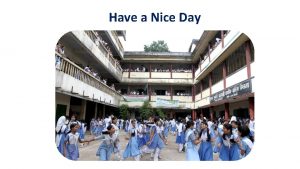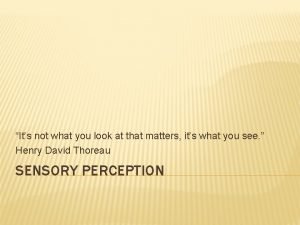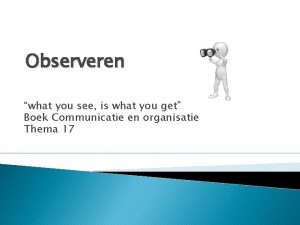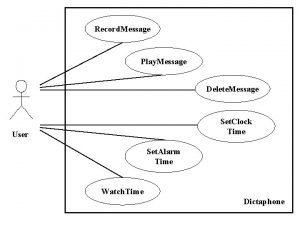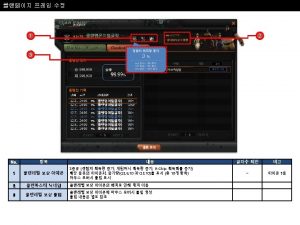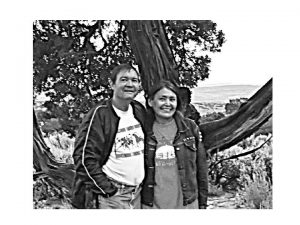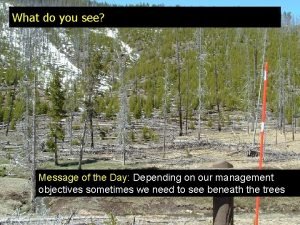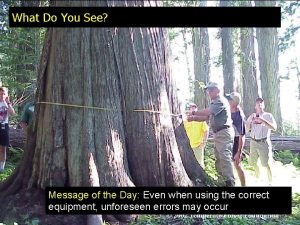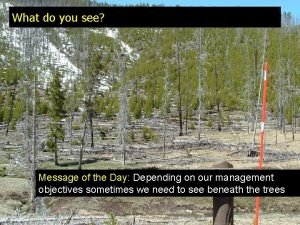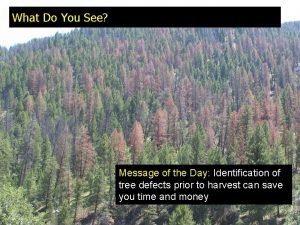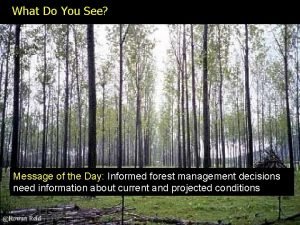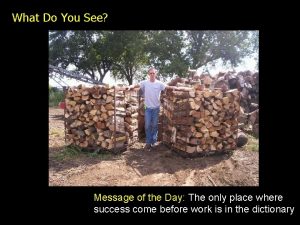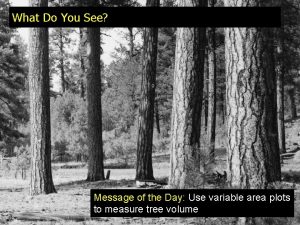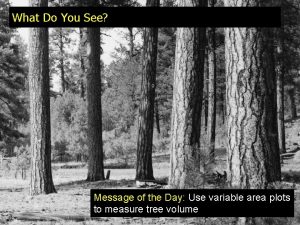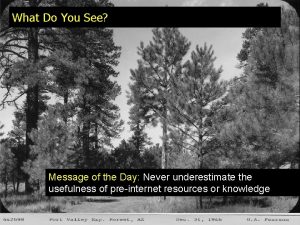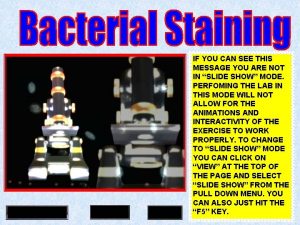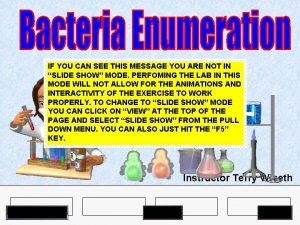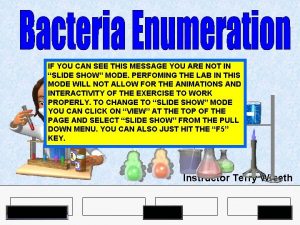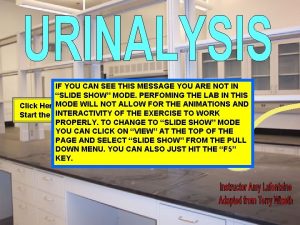What Do You See Message of the Day








































- Slides: 40

What Do You See? Message of the Day: Identification of tree defects prior to harvest can save you time and money

FOR 274: Defects on Standing Timber Defects • Prominent Features • Rots, Borers • Stem Rusts and Cankers • Wounds • Animal Damage and Insects • Defect Tables For More Information: FOR 468: Forest and Plant Pathology PS&ES: Forest Entomology and Insect Ecology

Defects: Introduction Assessment of defects in standing timber are highly site specific and typically covered during on the job training. • Defects result in timber loss; some minor, some complete. • Afflicted trees and logs need to be examined in order to adjust output predictions accordingly. • More Damage = Less Products • A system common to both buyer and seller must be used. Source: Partridge et al. A handbook of defect estimators for standing timber, USFS

Defects: Introduction It is common to classify deductions made for defects into hidden and visible. Hidden Defects: Lack external indicators Visible Defects: Based on visual evidence (and not hunches!) The main sources of visible defects are from natural defects (rots, insects, etc) and from mechanical / logging damage. Natural defects exist within the tree before it is felled. Mechanical defects can occur during logging, felling, and processing. USDA FS Region 6 Cruising Manual

Defects: Introduction Visible abnormalities that inform us of potential defects are called defect indicators. Common defect indicators include: Ø Butt swell Ø Sap rot Ø Conks Ø Crooks Ø Bark Seams Ø Catface Ø Broken Tops Ø Sucker Limbs Ø Fire Scare Ø Insect Damage Ø Sweep Ø Forks USDA FS Region 6 Cruising Manual

Defect Indicators: Prominent Features Swelling: A swelling is a bulge, mound, lump, or knob typically found under the bark Rusts only occur on live trees. Depressions: Examples include cankers, which are sunken areas on the stems Western Gall Rust Cankers are defined as “expanding patched of dead or dying bark and cambium” Atropellis Canker

Defect Indicators: Prominent Features Wound or Scars: Can be the result of mechanical damage or falling trees, such as broken or snapped-off branches. Lightning and fires can also cause scars Cracks or Splits: Examples can include splits caused by rapidly changing temperatures

Defect Indicators: Prominent Features Holes and Cavities: Insects and birds can leave behind holes on the stems. Frequently Wood Chips can be found at the base of affected trees. Fungus Parts: It is common to find signs of fungus such as conks, mushrooms, and toadstools.

Defect Indicators: Prominent Features Frass: This is fine powdering material that insects leave as waste after digesting plants. It also can refer to excavated wood shavings that ants and other borers (that do no eat the wood) remove as part of mining Pitch: Excessive amounts of pitch present with frass is a good indicator of insects Sweep or Crooks: This is when the stem is not straight

Defect Indicators: Prominent Features Broken Tops and Bases: When broken tops are present without decay, only the broken area +2’ below is culled. Various rots will often be present in these tops and bases. Bark Eaten or Ripped: Bears, deer, and elk commonly scratch or rip bark from stems. Generally these do not remove wood volume unless the tree does not heal.

Defect Indicators: Prominent Features Brooms: Often associated with mistletoe.

Defects: Root Rots Different types of rots can be identified by several visual indicators. Root rots kill fine roots in trees often resulting in wind thrown trees. In the Pacific Northwest, common root rots include: - Laminated root rot (Phellinius weirii & Porta werii) - Shoestring rot (Armillaria ostoyae) - White spongy rot (Fomes annosus)

Defects: Butt and Sap Rots Butt rots occur near the tree base, often resulting in butt swell. The volume loss in these trees are usually limited to the base of the butt log. Sap rots affect the outer edge of the tree stems. Snags are common hosts. In the Pacific Northwest, common sap rots include: - Purple conk (Polyporus volvatrus)

Defects: Butt and Heart Rots Heart rots affect the tree’s heartwood. Generally the size of the conks are a good indicator of the degree of damage. In the Pacific Northwest, common heart rots include: - White speck (Phellinus pini) - Indian paint conk (Echinodontium tinctorium) - Light brown cubical rot (Fomitopsis cajenderi)

Defects: Rots – Some Local Suspects Red Ring Rot Caused by Phellinus pini Targets larch and white pine What to Look For: Conks: 1 -12” across, hard to touch, conks are layered and usually yellowbrown color Defect: • Single conks on larch indicate total heartwood los • Multiple conks usually indicate total heartwood cull. • Single conks on non larch are culled 24 feet up and 4 -5 feet down from conks Red Ring Rot

Defects: Rots – Some Local Suspects Fibrous White Rot and Stem Rot Caused by Armillaria mellea Targets planted trees What to Look For: Fungus: white fans appears under bark at tree bases Rhizomoprhs: black fungus appears in and on the roots Mushrooms: light brown/honey color around tree bases in late fall Defect: • Generally decay extends upwards from base up to 5 feet Fibrous White Rot

Defects: Rots – Some Local Suspects Stringy Heart Rot Caused by Echinodontium tinctorium Targets hemlock and grand fir – major source of hardwood decay of true firs in the Northwest What to Look For: Hollow Trunks and decayed heartwood: fibrous, yellow, and circular Conks: large and hard below branches. Dark colored with bright red interior Knots: containing bright-red fungus Defect: • Single conk equates to 16 -50 feet of heartwood loss. Stringy Heart Rot

Defects: Rots – Some Local Suspects Red-Brown Root and Butt-Rot Caused by Phaeolus schweinitzii Targets Douglas fir and pines What to Look For: Conks: rare on trees, is present on duff beneath the trees. These area 618” and are dark brown. Increment bore: use at DBH Defect: • Single conk on or near the tree indicates 8 -12 feet of tapered decay in the first log. • Ants or dry habitats can cause decay to extend to above 32 feet. Red-Brown Root

Defects: Borers – Some Local Suspects Ponderous Borer Caused by Ergates spiculatas Targets standing dead Douglas fir and ponderosa pine What to Look For: Frass packed tunnels: observed in penetrated wood Defect: • Usually localized to lowest part of 1 st log. Ponderous Borer

Defects: Borers – Some Local Suspects Carpenter Ants – Campanotus spp. Targets conifer and hardwood heartwood in live trees What to Look For: Boring dust: dust piles appear below holes at the base of trees Tunnels: These are vertical and can be up to 1 cm wide and several feet long. Decay: These insects are usually associated with decay Defect: • frass indicates heavy damage and loss extended 10 -32 feet up tree. Carpenter Ants

Defects: Rusts and Cankers – Some Local Suspects Western Gall Rust Caused by Endocronartium harknessii Targets most 2 and 3 needles pines, including ponderosa, Scots, lodgepole What to Look For: Galls: Large galls form on stems and branches Orange spores masses: In spring these appear from the living galls Dead branches: Broken bark leads to branch and gall death Defect: • 3 feet in each direction of gall Western Gall Rust

Defects: Rusts and Cankers – Some Local Suspects White Pine Blister Rust Caused by Cronartium ribicola Targets most 5 needle pines, including white, limber, whitebark, etc What to Look For: Cankers: Old cankers will exhibit many cracks and swelling will be present above cankers Dead branches: Yellow to red-brown foliage will be common when branches above cankers are killed Bark discoloration: in spring, blisters appear as small (1 -3 mm) yellow to light-brown patched. Once dried, the dark lesions are visible all year round. White Pine Blister Rust

Defects: Rusts and Cankers – Some Local Suspects White Pine Blister Rust Caused by Cronartium ribicola Targets most 5 needle pines, including white, limber, whitebark, etc What to Look For: Blisters: within the lesions, white blisters appear that contain powdery, orange-yellow spores. Blisters will develop each year until the stem above a canker is killed. Defect: • Only cull killed tops and branches White Pine Blister Rust

Defects: Rusts and Cankers – Some Local Suspects Atropellis Cankers Caused by Atropellis spp. Only affects pines What to Look For: Cankers: Perennial – the wood beneath each canker is streaked blue -black or grey-green Fungi: black discs appear on bark of cankered areas Defect: • Common to use a 15% deduction for logs with canker Atropellis Canker

Defects: Wounds Mechanical Wounds: Defects usually limited to the wound area unless there are other signs of decay Sweep or Crook: Stem is usually divided up into as many useable sections as possible.

Defects: Animal Damage No defect: Damage resulting from bears, elk and sapsuckers generally do not result in any cull Woodpecker Damage: Presence of woodpecker holes generally indicate that insect borers and heartwood loss is present

Defects: Bark Beetles and Stem Insects Mountain Pine Beetle Dendroctonus ponderosae Affects lodgepole pine, ponderosa pine, western white pine, whitebark pine, and limber pine What to Look For: White pitch tubes: seen in the lower stem with red boring dust present Red attack: Foliage rapidly turns red Defect: • Sapwood to a depth of 10” will be heavily stained. • No defect except eventual tree mortality

Defects: Bark Beetles and Stem Insects Western Pine Beetle Dendroctonus brevicomis Affects lodgepole pine, ponderosa pine, and western white pine What to Look For: White pitch tubes: seen in the lower stem with red boring dust present Galleries: Maze-like and crisscrossing Defect: • Sapwood to a depth of 10” will be heavily stained.

Defects: Bark Beetles and Stem Insects Pine and Spruce Engravers Ips spp. Affects pines and spruces What to Look For: Change in color: tree turn grey-green and then yellow, followed by light brown Galleries: Egg galleries radiate from a central chamber Defect: • Tree mortality • Sapwood is often stained blue leading to loss in value

Defects: Estimating Logs Once a defect has been identified the quantity of useable logs can be estimated.

Defects: The Cubic Approach In the cubic approach each sawlog can have up to 60% defect. Non-sawlogs products are cruised for gross volume with no deductions made USDA FS Region 6 Cruising Manual

Defects: The Scribner Approach In the Scribner approach each sawlog can have up to 66% defect. Non-sawlogs products are cruised for gross volume with no deductions made USDA FS Region 6 Cruising Manual

Defects: Trunk Injuries When dealing with fire scars, basal, and trunk injuries deductions are only made if there is volume loss. Scribner defects are only counted if the defect penetrates the scaling cylinder. USDA FS Region 6 Cruising Manual

Defects: Trunk Injuries Lightning scars will cause defects using both the cubic and Scribner methods. USDA FS Region 6 Cruising Manual

Defects: Crooks and Sweeps USDA FS Region 6 Cruising Manual

Defects: Defect Tables Sap rot: deduct the full % Weather checks: deduct half the % if straight defect and full % of spiral If defect > 60%: Log is non-saw with no defect USDA FS Region 6 Cruising Manual

Defects: Defect Tables Example: A 32” small end diameter log has damage averaging 1. 5” in depth affecting the whole circumference. Total defect depth (2 sides) = 3” Total log defect = 18% USDA FS Region 6 Cruising Manual

Defects: Defect Tables Sap rot and weather checks: deduct the full % If defect > 66%: Log is non-saw with no defect USDA FS Region 6 Cruising Manual

Defects: Defect Tables Example: A 20” small end diameter log has weather checks averaging 4” in depth affecting the whole circumference. Total defect depth (2 sides) = 8” Log is a non-saw log with no defect Total log defect = 71% USDA FS Region 6 Cruising Manual

Extra Credit (due Monday) What are the main factors that affect quality in a log? Hint: Look at the recommended reading
 Day 1 day 2 day 3 day 4
Day 1 day 2 day 3 day 4 Day 1 day 2 day 817
Day 1 day 2 day 817 See you again have a nice day
See you again have a nice day It's not what you look at that matters, it's what you see.
It's not what you look at that matters, it's what you see. If you could see the future what would you do
If you could see the future what would you do Good morning nice to see you
Good morning nice to see you Buenas tardes good afternoon
Buenas tardes good afternoon What you see is what you get
What you see is what you get It was such a foggy day that we couldn't see the road
It was such a foggy day that we couldn't see the road Summary of count that day lost
Summary of count that day lost George eliot count that day lost
George eliot count that day lost Pgcps calendar a day b day
Pgcps calendar a day b day Oceans apart day after
Oceans apart day after Day to day maintenance
Day to day maintenance As your room gets messier day by day, entropy is
As your room gets messier day by day, entropy is I don't know about tomorrow i just live from day to day
I don't know about tomorrow i just live from day to day Wilt thou be gone it is not yet near day
Wilt thou be gone it is not yet near day Growing day by day
Growing day by day Define seed dormancy
Define seed dormancy Conclusion of seed germination
Conclusion of seed germination Geotropism
Geotropism I live for jesus day after day
I live for jesus day after day Glorious day one day when heaven
Glorious day one day when heaven Day one day one noodle ss2
Day one day one noodle ss2 Day one day one noodles ss2
Day one day one noodles ss2 Hát kết hợp bộ gõ cơ thể
Hát kết hợp bộ gõ cơ thể Frameset trong html5
Frameset trong html5 Bổ thể
Bổ thể Tỉ lệ cơ thể trẻ em
Tỉ lệ cơ thể trẻ em Voi kéo gỗ như thế nào
Voi kéo gỗ như thế nào Thang điểm glasgow
Thang điểm glasgow Hát lên người ơi
Hát lên người ơi Các môn thể thao bắt đầu bằng tiếng bóng
Các môn thể thao bắt đầu bằng tiếng bóng Thế nào là hệ số cao nhất
Thế nào là hệ số cao nhất Các châu lục và đại dương trên thế giới
Các châu lục và đại dương trên thế giới Công thức tính độ biến thiên đông lượng
Công thức tính độ biến thiên đông lượng Trời xanh đây là của chúng ta thể thơ
Trời xanh đây là của chúng ta thể thơ Cách giải mật thư tọa độ
Cách giải mật thư tọa độ Làm thế nào để 102-1=99
Làm thế nào để 102-1=99 Phản ứng thế ankan
Phản ứng thế ankan Các châu lục và đại dương trên thế giới
Các châu lục và đại dương trên thế giới


